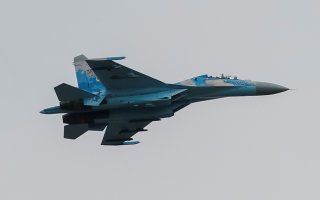Su-27 Flanker: This Russian Jet Just Won’t Die
Despite the growing proliferation of stealth aircraft, the Su-27 will likely stay in service in conflict scenarios of lower intensity, against adversaries that do not have stealth aircraft or advanced air defenses.
The legendary Sukhoi design bureau has notched a number of notable successes in designing airframes for the Soviet Union and the Russian Federation. Among those airframes is the Cold War-era Su-27 design, which continues to be useful decades after it was designed.
No conversation about the Su-27 is complete without its origin story, its troubled birth in the Soviet Union at the end of the Cold War.
The Su-27 is a Soviet design that adhered to the high-low mix theory of air combat, in which a large number of smaller, less capable, and less expensive aircraft are complemented by a smaller number of more capable (and therefore more expensive) aircraft.
This arrangement serves as a force multiplier, allowing the total number of aircraft to be as effective as a larger number of aircraft. The original Su-27 high-low complement was the MiG-29, which is aerodynamically similar, albeit with a much smaller airframe and being considerably less capable.
The Su-27 was designed as a direct competitor to the American F-14 and F-15 families of aircraft. Its capable design reflects this. The Su-27 has a top speed of about Mach 2.35 and has up to ten hard points for missiles or bombs.
As a long-range air superiority fighter, the Su-27 was intended to keep an eye on the Soviet Union’s borders, protect against American and NATO bomber incursions, and be a multi-role fighter.
Given its (at the time) long-range capabilities, the Su-27 was also intended as an escort fighter for Soviet long-range bombers such as the Tu-160 “Blackjack,” Tu-22M “Backfire,” and Tu-95 “Bear” — additional Soviet-era designs that continue to serve in their original bomber roles in Russia today.
It is also exceptionally agile: the Su-27, and later more advanced variants of the family, are flown by the Russian Knights, an aerobatic demonstrator team similar to the Blue Angels in the United States.
This is due to the Su-27’s super maneuverability: the airframe is capable of Pugachev’s Cobra, a maneuver in which an aircraft flying at low-to-moderate speed quickly raises its nose, the airframe acting as a large airbrake and rapidly decelerating, then lowering its nose and accelerating away.
Like many interesting Soviet tanks, aircraft, and weapons designs, steady incremental improvements have increased their service lives. There is also a dizzying array of Su-27 variants developed both for the Soviet Union as well as the Russian Federation, and for export. The Flanker family of aircraft are also essentially improvements on the initial Su-27 design that incorporate better avionics, extended range, or additional capabilities, like a ground attack.
Therein lies the Su-27’s success. It is a capable and agile airframe that has grown and improved in increments, into the broad Flanker family of aircraft that are still in service today, both within former Warsaw Pact countries, but also widely distributed within the Middle East, Latin America, and Africa.
Despite the growing proliferation of stealth aircraft, the Su-27 will likely stay in service in conflict scenarios of lower intensity, against adversaries that do not have stealth aircraft or advanced air defenses.
Caleb Larson is a multimedia journalist and defense writer with the National Interest. A graduate of UCLA, he also holds a Master of Public Policy and lives in Berlin. He covers the intersection of conflict, security, and technology, focusing on American foreign policy, European security, and German society for both print and radio. Follow him on Twitter @calebmlarson
Image: Reuters

